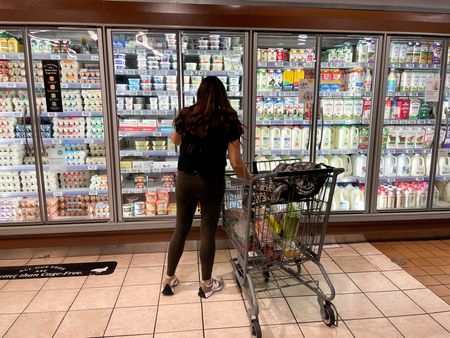By Lucia Mutikani
WASHINGTON (Reuters) – The U.S. economy rebounded strongly in the third quarter amid a shrinking trade deficit, but the data overstated the nation’s economic health as domestic demand was the weakest in two years because of the Federal Reserve’s aggressive interest rate hikes.
The Commerce Department’s advance third-quarter gross domestic product report on Thursday also showed residential investment contracting for a sixth straight quarter, the longest such stretch since the housing market collapse in 2006, as the sector buckles under the weight of soaring mortgage rates.
While overall inflation slowed substantially from the second quarter, underlying price pressures continued to bubble.
Still, the return to growth after two straight quarterly declines in GDP offered evidence that the economy was not in a recession, though the risks of a downturn have increased as the Fed doubles down on rate hikes to battle the fastest-rising inflation in 40 years.
“Despite the shiny headline number, a look under the hood shows a much grimmer picture of the U.S. economy, one that is clearly losing steam,” said Sal Guatieri, a senior economist at BMO Capital Markets in Toronto. “With the full effect of past and future Fed rate hikes still to be felt, the economy appears poised for a modest downturn in the first half of next year.”
Gross domestic product increased at a 2.6% annualized rate last quarter after contracting at a 0.6% pace in the second quarter. Economists polled by Reuters had forecast GDP growth would rebound at a 2.4% rate, with estimates ranging from as low as a 0.8% rate to as high as a 3.7% pace.
The trade deficit narrowed sharply as slowing demand curbed the goods import bill. Exports also increased during the quarter. The smaller trade gap added 2.77 percentage points to GDP growth, the most since the third quarter of 1980.
Final sales to private domestic purchasers, which exclude trade, inventories and government spending, edged up at only a 0.1% rate, a sign that higher borrowing cost were starting to erode demand. That was the slowest rise in this measure of domestic demand since the second quarter of 2020 and followed a 0.5% rate of increase in the second quarter.
“GDP growth cannot be sustained without domestic private-sector growth,” said Chris Low, chief economist at FHN Financial in New York.
The data will probably have little impact on monetary policy, though Fed officials could draw some comfort from the ebbing demand. Personal consumption expenditures price data for September and third-quarter labor cost numbers, due to be released on Friday, could carry more weight ahead of the U.S. central bank’s Nov. 1-2 policy meeting.
The Fed has raised its benchmark overnight interest rate from near zero in March to the current range of 3.00% to 3.25%, the swiftest pace of policy tightening in a generation or more.
Stocks on Wall Street were trading mixed. The dollar rose against a basket of currencies. U.S. Treasury yields fell.
CONSUMER SPENDING SLOWS
Growth in consumer spending, which accounts for more than two-thirds of U.S. economic activity, slowed to a 1.4% rate from the April-June period’s 2.0% pace.
Spending was held back by a decrease in goods, mostly motor vehicles as well as food and beverages. That partly reflects motor vehicle shortages and a shift in spending to services. Outlays on services increased, lifted by healthcare and international travel.
Consumer spending is being supported by a strong labor market, which is driving up wages. The Labor Department reported on Thursday a modest rise in the number of people filing new claims for unemployment benefits last week.
Initial claims for unemployment benefits increased 3,000 to a seasonally adjusted 217,000 for the week ended Oct. 22. Claims have remained significantly low despite reports of layoffs at companies, mostly in sectors sensitive to interest rates.
“Even as the economy slows, employers appear to be reluctant to lay off workers that they have struggled to hire and retain,” said Nancy Vanden Houten, lead U.S. economist at Oxford Economics in New York. “We don’t look for claims to fall much below current levels, but we don’t look for a significant rise in claims or unemployment either until we enter a recession.”
Companies boosted spending on equipment such as trucks, aircraft and computers last quarter. But that bounce could fizzle, with a third report from the Commerce Department showing an unexpected drop in orders for non-defense capital goods excluding aircraft in September. Businesses also increased investment in software as well as research and development.
There were, however, further cutbacks in the construction of commercial and healthcare structures among others. Government expenditures rebounded after five straight quarters of decline, led by defense spending as well as an increase in compensation for state and local government workers.
There was some encouraging news on inflation. A broader measure of inflation in the economy rose at a 4.6% rate, decelerating from a 8.5% pace of increase in the second quarter.
As a result, income at the disposal of households after accounting for inflation rebounded at a 1.7% pace after decreasing at a 1.5% rate in the second quarter. The saving rate dipped to 3.3% from 3.4%.
But inflation remains uncomfortably high. The personal consumption expenditures price index excluding the volatile food and energy components rose at a 4.5% rate after increasing at a 4.7% rate in the prior quarter.
With demand for goods cooling and supply chain bottlenecks easing, retailers are saddled with excess merchandise, forcing them to slow down their pace of inventory accumulation.
Business inventories increased at a rate of $61.9 billion after rising at a pace of $110.2 billion in the second quarter. Inventories subtracted 0.7 percentage point from GDP growth.
“Inventories, which used to jam the ports, have moved to the warehouses of the retailers exactly when the demand is softening and employment gains are slowing,” said Sung Won Sohn, finance and economics professor at Loyola Marymount University in Los Angeles. “As the inventory correction process proceeds, the economy could slide into a recession.”
(Reporting by Lucia Mutikani; Editing by Chizu Nomiyama, Andrea Ricci and Paul Simao)


